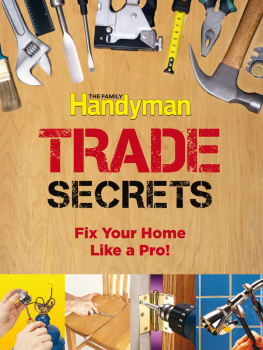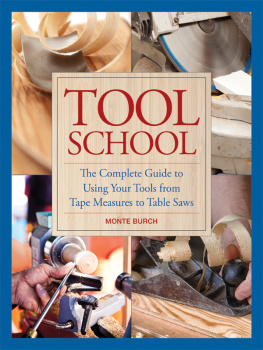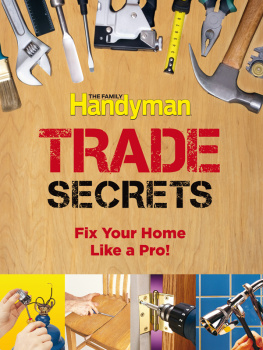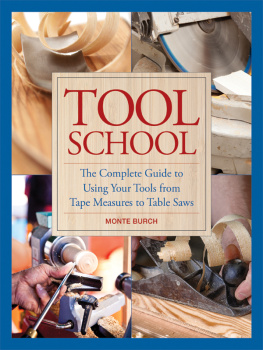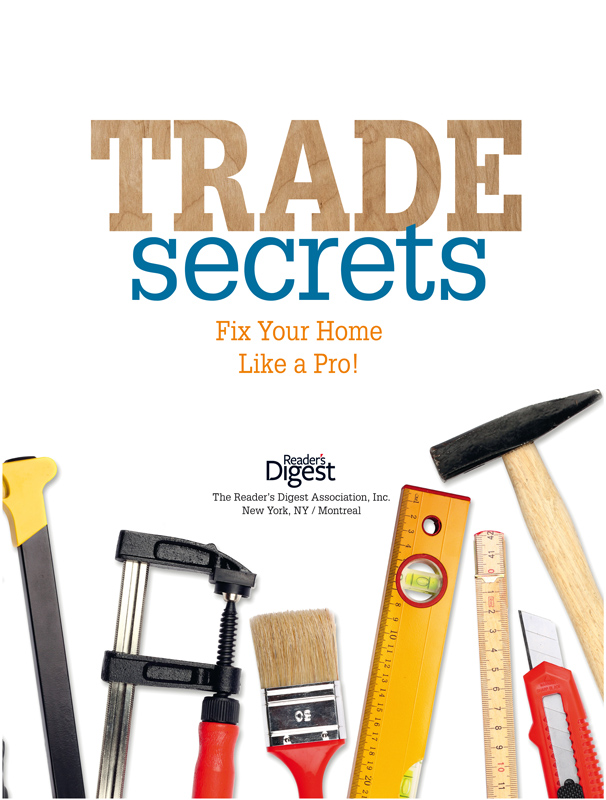Contents

Introduction
Have you ever paid a repairman lots of money to do a job you later realized you could have done yourself? If only you'd had a little more confidence and a bit of practical guidance you could have built that shelf, installed that window or fixed that wonky cabinet door, and not only saved some money but boosted your self esteem as well.
Building, repairing and decorating have been part of human DNA since we first built shelter so don't be surprised if you hear a little voice in your head saying, Go on! You can do it, it can't be that hard, when something needs doing around your home.
And it isn't that hard. Although some more complex jobs are best left to the experts, there are so many day-to-day home repairs, maintenance and improvements that you can master with just a few tricks of the trade.
This is why we created Trade Secrets. Many DIY publications are quite technical and complicated, with a high level of assumed knowledge, leaving many would-be-home handy-people floundering in alien terminology and confusing diagrams.
This commonsense guide to everyday home maintenance, repairs and decorating is not that kind of book. It tells you how to go about a task, what to use and how to use itthe way a professional would. You won't need to turn this book upside down with your tongue protruding from the side of your mouth to make sense of the many photos, illustrations and tips.
Trade Secrets fills the gap between Haven't got a clue and Almost a pro and empowers the enthusiastic amateur to fulfill his or her destiny.
So get off that couch and get to work! There's no job in Trade Secrets that you can't do if you apply the easy-to-follow advice and set your mind to it.
Every journey starts with a small step. Make that little voice go away.
The DIY editors of Reader's Digest
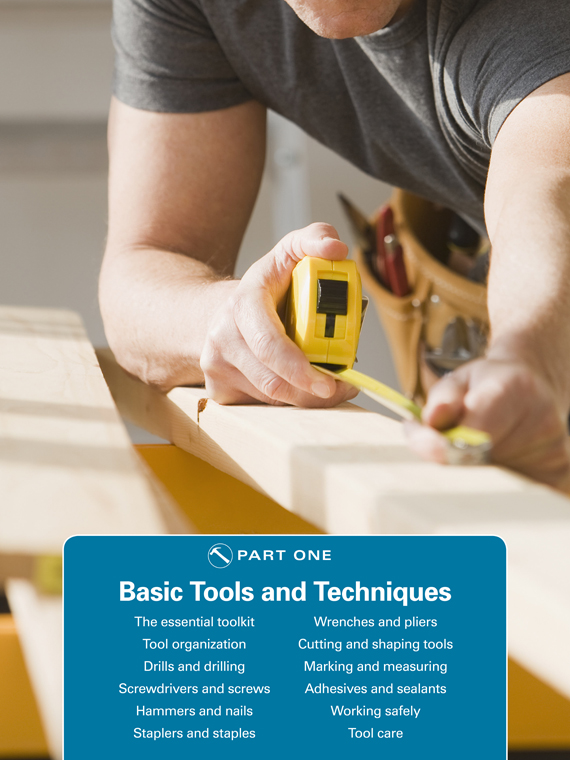
The essential toolkit
A surprisingly small number of tools can cope with a wide range of repair and maintenance jobs around the house. Keep these tools together in a lightweight toolbox or bag, and you will save both time and effort whenever something needs fixing.
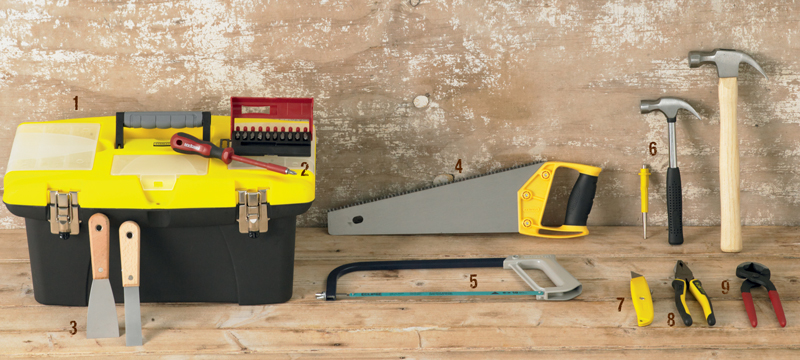
The toolbox
To start with, choose a light but robust plastic case with a lift-out tray for small tools. Avoid metal toolboxes; they are heavy to carry around and they rust.
Screwdrivers
Screws have head recesses of various sizes and types, so screwdriver sets make sense. Those with a master handle that accepts the different bits can save space.
Putty knives
Simply a handle with a flexible steel blade, for applying filler. Buy 1 in. (2.5 cm) and 2 in. (5 cm) knives for everyday use. Don't confuse it with a scraper, which has a stiffer blade.
Saw
A compact or toolbox saw with fine-point hardened teeth will handle all sorts of household woodwork jobs such as trimming cleats or cutting a shelf to length.
Hacksaw
Hacksaws are designed to cut metal, but will also cut through plastica curtain rod, for exampleand small wood sections. The saw can be inexpensive, but the replaceable blades should be good quality.
Hammers and nail punch
You will need a 16 oz. (450 g) claw hammer, which is fine for most DIY jobs, and possibly a smaller 812 oz. (225350 g) model for lighter or finishing work. Also buy a nail punch, used to drive nail heads below the wood surface.
Knife
A utility knife with replaceable blades is a DIY essential. There are different blades available: for easy jobs such as paper and plastic sheeting, or for tougher materials such as carpet and linoleum. Choose a knife with a retractable bladeit's safer.
Pliers
The serrated jaws of pliers are useful for gripping, twisting and cutting wire, and for straightening bent metal.
Cutting pliers
Cutting pliers are designed for pulling out tacks and nailsfrom floorboards, for examplebut can also be put to other tasks, such as removing picture hooks without damaging the wall, or as a ceramic tile cutter.
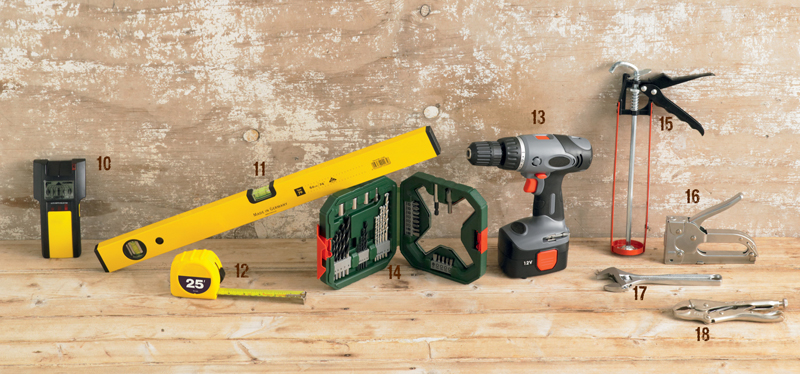
Cable, pipe and stud detector
Look for one that detects electrical cables and plumbing pipes buried in house walls, plus ceiling joists and the wood framing inside a partition wall.
Level
A 24-in. (60 cm)-long level will handle inside jobs such as fitting shelves and hanging pictures. Outdoor jobs such as erecting privacy screens, posts and fences may require a longer version.
Tape measure
An ideal size is a 16 ft. (5 m) steel tape, which will cope with measuring up a room as well as smaller jobs. Some have both centimeter/meter and inch/foot markings, so if need be, you can use the tape as a conversion device.
Drill
A cordless drill/screwdriver, about 12 volts, with rechargeable batteries is a must. It should have forward and reverse, fast and slow speeds, and be comfortable and not too heavy to handle.
Drill bits
Look for a set that includes masonry, high-speed steel twist and brad-point bits (for wood), as well as a range of screwdriver bits. Drill bit sets often come with the electric drill.
Caulking gun
This inexpensive tool is needed for extruding the contents of the many ready-to-use fillers, sealants and adhesives sold in standard-sized cartridges.
Hand staple gun
Choose one that can handle flat staples for jobs such as fastening webbing, fabric or netting, as well as curved staples for speaker and low-voltage cables.
Adjustable wrench
Look for an adjustable wrench that opens up to about 1 in. (3 cm)good for plumbing fixtures, and smaller nuts, too. Buy a reputable brand; the jaws on cheap tools may slip or jam.
Vice-grip pliers
This versatile tool can be used like a pair of pliers or as a makeshift extra wrench. It has adjustable, lockable jaws that will clamp firmly and hold different-shaped objects.
Tool organization
Here is a handful of clever ideas that will help you save time and money while keeping your enthusiasm high.
When you need to drill into tough materials such as concrete and masonry, use a masonry bit with a carbide tip.
Tool bucket bags
You can buy these bags that hang in a sturdy bucket, or make your own by riveting a couple of canvas toolbelts to the rim of a bucket. Popular alternatives are bucket-or briefcase-shaped tote bags with lots of compartments.
Mobile workbench
Ever wish you had a lightweight, mobile workbench? Here's the answer. Screw a length of MDF to an old ironing board and you'll have a handy workbench that can be moved easily and adjusts to whatever height you need to work comfortably. Remember, lightweight work only.

